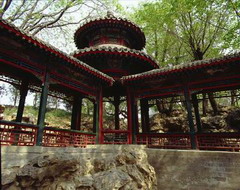Hall of Benevolent Longevity
On turning right after entering the garden from East Palace Gate and turn right, one would see the magnificent Hall of Benevolent Longevity.
Originally named the Hall of Industrious Government, the hall was first built in 1750 and is the main hall in the Summer Palace. It was the place where Empress Dowager Cixi and Emperor Guangxu took charge of state affairs. In 1860, when the Anglo-French allied forces invaded Beijing, the original building was burned down. In 1890, the hall was rebuilt and renamed as Hall of Benevolent Longevity by Emperor Guangxu.
Bronze animals, cauldrons, dragons and phoenixes were placed in front of the hall, An animal called Kylin is considered the most attractive.The legendary animal has a dragon's head, lion's tail, deer's antlers,  ox's hooves with a body covered with fish scales, Dignified and stately, they add more solemnity to the hall.
ox's hooves with a body covered with fish scales, Dignified and stately, they add more solemnity to the hall.
The first thing to be seen on entering the hall, is a red sandalwood throne carved with nine dragons, which is the symbol of supreme power. By the side of the throne, two big fans made of peacock feathers were put up to give a solemn atmosphere. In the Song dynasty, two eunuchs would hold the fans, but in the Qing dynasty, the two fans were fixed by the side of the throne.
Behind the throne is a red sandalwood screen, on which 226 Chinese characters meaning "longevity" were written with 100 bats in the background, symbolizing happiness and longevity. A tablet is hung above the throne, on which is an inscription meaning those who show benevolence in the government of the people will live a long life.
Several incense burners of various shapes are also placed in the hall. Incense was burned in them on formal occasions..
The two side chambers were prepared for the emperors to rest and receive officials on formal occasions.
Several incense burners of various shapes are also placed in the hall. Incense was burned in them on formal occasions.
The two side chambers were prepared for the emperors to rest and receive officials on formal occasions.

